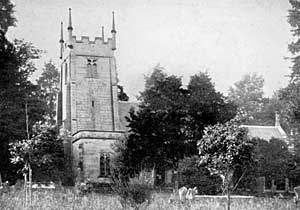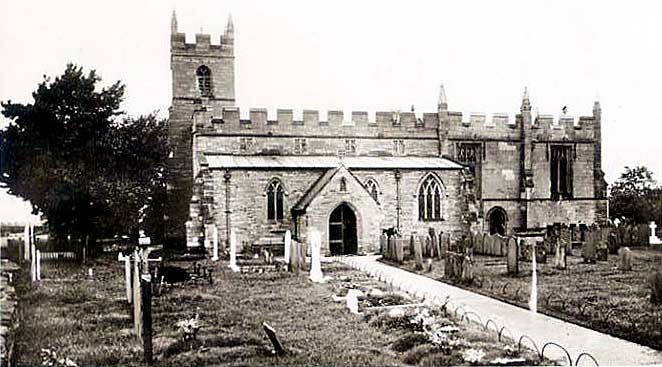< Previous | Contents | Next >
The Sleeping Lady
WIDMERPOOL. In the heart of the Wolds, amid some of the loveliest woodland scenery in the county, is this charming village, where a delightful walk leads to the church in the lovely grounds of the hall, a stone house with tower and terraces, and a dell which is a fairyland of flowers and trees.

Widmerpool church in 1900.
We shall not soon forget the little church, for it shelters an exquisite thing. In a dimly lighted chamber lies a beautiful woman asleep, her head on a cushion, a spray of lilies in her hand, a smile on her lips, and on her tomb the words:
Thinking that our remembrance, though unspoken, may reach her where she lives.
It was an Italian sculptor who fashioned her in white marble here, working with great skill on every detail of her gown, her dainty lace, her cushion with a tasselled cord, her patterned pillow, and her coverlet of lovely folds. She was Harriet Annie Robertson, the lady of the Hall, who with her husband bore the cost of the charming restoration of the church. They were beloved by all who knew them.
There are many cedars among the fine trees here, one near the church growing higher than the 14th century tower, which is almost all that is left of the old building. St Peter stands in a niche on the porch, and a door with lovely hinges lets us inside, where the glory is in the chancel. Bosses of leaves adorn its vaulted roof, the windows have clustered shafts with capitals of flowers and foliage, the stone reredos has rich carving of a holy lamb and the signs of the Evangelists, and angels are singing in the tracery of the stalls.
A lovely relic is the 14th century font, which has been given an oak rim carved with flowers. The register tells of a child baptised in it on the day Charles Stuart was beheaded, and an echo of his day clings to the churchyard, where in two unknown graves sleep two soldiers slain at Willoughby Field in the closing years of the Civil War, when the king's men were routed.
A Poet's Inspiration
WILFORD. Its memories are of a curious scholar, an adventurer, and a poet who loved it when its charms were often sung and its landscape often painted.

Henry Kirke White
The poet was Henry Kirke White, who found here and at Clifton the inspiration of much of his best work. Born in Nottingham, he came with his books to stay in the village while preparing for the university, and lodged in a cottage with a garden reaching down to the river. There he would dream as he looked out on a scene which was Wilford's great joy, a never-to-be-forgotten landscape of swift-flowing river, meadowland carpeted with crocuses in spring, and Nottingham with its castle silhouetted against the sky. He lies at Cambridge, where he died, but it was in Wilford churchyard that he longed to be, for he wrote:
Here would I wish to sleep. This is the spot
Which I have long marked out to lay my bones in.
Tired out and wearied with the riotous world,
Beneath this yew would I be sepulchred.
Kirke White, who has a modest place in literature, was born in 1785, the son of a butcher who took him early from school and set him to deliver meat before apprenticing him to the stocking loom. Inheriting his talent from his mother, who had been a schoolmistress, the boy showed fine resolution in study and, being transferred to the office of a firm of lawyers, made such progress in Latin that he was reading Horace within a year, and had begun the study of Greek and modern languages. From an early age he wrote verse, and he wrote "Clifton Grove" to raise his university fees. Friends helped him to Cambridge, where his natural abilities placed him first in every examination and promised a dazzling career; but his health broke down and he died at 21.
The reviewers had not been kind to his poems, but Southey championed him royally, wrote his life, and published his works. The sympathy of Byron was stirred, and he wrote:
Unhappy White! while life was in its spring
And thy young muse just shook her joyous wing,
The spoiler came; and all thy promise fair
Has sought the grave, to sleep forever there.
'Twas thine own genius gave the final blow
And helped to plant the wound that laid thee low.
Posterity has not endorsed this high opinion, but all the stricken poet's work was written before manhood rounded his broken youth. Yet his name still goes sounding round the world, for the hymn "Oft in danger, oft in woe," is one of half a score of hymns by which congregations still remember him.
Wilford has changed since those days, and a coalmine and a power station stand across the river where the poet saw flowers, but the toll bridge which replaced the ferry has helped it to keep some of its quiet charm. It has still the green with a delightful group of homes founded by Lord Trent for veterans of the Crimea and the Mutiny: the old church has the 18th century rectory for company, and an old tithe barn and the old inn are close by.
To the old school, founded by a rector 200 years ago and rebuilt last century, came Gilbert Wakefield as a boy of nine in 1765. We do not wonder that he grew up to be a great scholar when we read what he says of his schooldays here:
We came into school at five in summer, and, with less than two hours for breakfast and dinner, continued there till six at night.
He lived on into the first year of the 19th century, a learned man of great impetuosity and extreme opinions, which in the end brought him to prison for libel. He had declared that the working classes would lose nothing by a French invasion and had roused a storm of protest by his controversial attitude on various subjects. A kindly man, he was fanatical and extreme, full of sympathy but lacking restraint. Born at St Nicholas's rectory, Nottingham, he lies at Richmond.
 Wilford church in the 1920s.
Wilford church in the 1920s. Wilford church is mainly medieval. The low tower and the fine chancel are 15th century; from the close of the 14th come the porch, the nave arcades and the chancel arch, and most of the south aisle, which has a piscina of 1300 and four floorstones of the 12th and 13th centuries. The old stairway still climbs to the loft and the roof. There is beautiful modern craftsmanship in the handsome chancel screen, the screen of the tower and the vestry, and the benches with traceried ends. A fine Kempe window has twelve minstrel angels, and a vivid window with the Wise Men is in memory of Kirke White. His medallion portrait is on a wall.
When we came to the village George Smith had just died in his hundredth year, after spending half his life as parish clerk.
Under a railed-in tomb in the churchyard sleeps Captain John Deane, who began life as a butcher's boy and ended it as a British Consul. He spent the last quarter of his life at Wilford, and built here two houses still known by his name. Once on a barren island Deane and his crew were reduced by privation to such terrible straits that the living ate the dead. Rescue came when all but the last hope was gone, and Deane with the surviving few returned to England, penniless.
Misfortune had not broken his spirit, however, for in 1714, when he was 35, he was appointed to the command of a ship in the Russian Navy. He remained for seven years in the service of the Tsar and then, remembering that he was still an Englishman, resumed national duty and for 17 years was a capable and respected member of the consular service, with posts at various ports in the Netherlands. It was as a veteran of nearly threescore years that he eventually returned to his native county to become a citizen of note. Having escaped so many perils at sea, he experienced his greatest danger at home, for in a field adjoining his grounds he was robbed and almost murdered by a thief, who expiated the crime on the gallows.
This was John Deane's last adventure; he lived to be 81, to die in peace, and to be buried here in the old churchyard.
